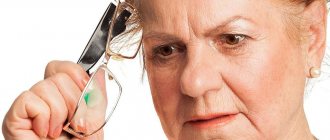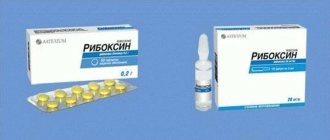Many therapists, cardiologists and endocrinologists call vegetative-vascular dystonia (synonym - neurocirculatory dystonia) the most common disease, which occurs in almost every second person. But in the International Classification of Diseases, the main document for doctors, there is no such diagnosis. You won’t find it in the records of doctors who work outside the CIS.
It turns out that there is no such disease. But many people experience very real symptoms of VSD. Where do they come from? And what to do if you have been diagnosed with VSD?
Soviet myth about vegetative-vascular dystonia
Due to the lack of direct access to a database of sources of evidence-based medicine in the USSR, the diagnosis “vegetative-vascular dystonia” was born, which doctors (usually of the old school) still give right and left to people aged 12 to 60 years. But in not a single developed country in the world is there a doctor who would give a patient such a diagnosis. It simply doesn't exist.
The diagnosis of VSD is a rudiment of Soviet medicine in the modern world, which rather indicates that the doctor does not understand the real causes of the ailment.
At the moment, the closest real-life disease to the diagnosis of VSD is somatoform dysfunction of the autonomic nervous system. This disease is dealt with by a psychiatrist and a neurologist, and often a psychologist is also involved for supportive therapy.
There is not and has never existed any research method that could confirm the diagnosis of “vegetative-vascular dystonia”. This is not a disease, but rather a condition of the body, which indicates the need to search for the real cause of the ailment.
Effective therapy for vegetative-vascular dystonia in young patients
The term “vegetative-vascular dystonia” (VSD) is often understood as psychogenically caused multisystem autonomic disorders, which can be an independent nosology, and also act as secondary manifestations of somatic or neurological diseases. At the same time, the severity of vegetative pathology aggravates the course of the underlying disease. Vegetative-vascular dystonia syndrome significantly affects the physical and emotional state of patients, determining the direction of their seeking medical help. In the structure of general morbidity, disorders of the autonomic nervous system occupy one of the leading places (category G90.8 according to ICD-10). Thus, the prevalence of vegetative-vascular dystonia in the general population, according to various authors, ranges from 29.1% to 82.0% [1–3].
One of the most important features of VSD is the polysystemic nature of clinical manifestations. Vegetative-vascular dystonia includes three generalized syndromes. The first is psychovegetative syndrome (PVS), which manifests itself as permanent paroxysmal disorders caused by dysfunction of nonspecific brain systems (suprasegmental autonomic systems). The second is the syndrome of progressive autonomic failure and the third is the vegetative-vascular-trophic syndrome [4].
Anxiety spectrum disorders are observed in more than half of patients with VSD. They acquire particular clinical significance in patients with a somatic profile, including functional pathology, since in these cases there are always anxious experiences of varying degrees of severity: from psychologically understandable to panic or to generalized anxiety disorder (GAD). As everyday practice demonstrates, all patients with this type of disorder are prescribed anxiolytic or sedative therapy. In particular, various tranquilizers are used: benzodiazepines, non-benzodiazepines, antidepressants. Anxiolytic therapy significantly improves the quality of life of these patients and contributes to their better compensation during the treatment process. However, not all patients tolerate these drugs well due to the rapid development of side effects in the form of lethargy, muscle weakness, impaired attention, coordination, and sometimes symptoms of addiction [5]. Taking into account the noted problems, in recent years there has been an increasing need for drugs with an anxiolytic effect of a non-benzodiazepine structure. These may include the drug Tenoten, which contains antibodies to the brain-specific protein S-100, which have undergone technological processing during the production process. As a result, Tenoten contains release-active antibodies to the brain-specific protein S-100 (PA-AT S-100). It has been shown that release-active drugs have a number of typical characteristics that allow them to be integrated into modern pharmacology (specificity, non-addiction, safety, high efficiency) [8, 9].
The properties and effects of release-active antibodies to the brain-specific protein S-100 have been studied in many experimental studies. Drugs created on their basis are used in clinical practice as anxiolytic, vegetative-stabilizing, stress-protective agents for the treatment of anxiety and autonomic disorders. The molecular target of PA-AT S-100 is the calcium-binding neurospecific protein S-100, which is involved in the coupling of information and metabolic processes in the nervous system, signal transmission by secondary messengers (“messengers”), the processes of growth, differentiation, apoptosis of neurons and glial cells [8]. In studies on the Jurkat and MCF-7 cell lines, it was shown that PA-AT S-100 exerts its action, in particular, through the sigma1 receptor and the glycine site of the NMDA glutamate receptor. The presence of such an interaction may indicate the influence of the drug Tenoten on various mediator systems, including GABAergic and serotonergic transmission [7, 10, 11].
It should be noted that, unlike traditional benzodiazepine anxiolytics, PA-AT S-100 does not cause sedation and muscle relaxation. In addition, PA-AT S-100 contributes to the restoration of neuronal plasticity processes.
S. B. Shvarkov et al. found that the use of RA-AT S-100 for 4 weeks in patients with psychovegetative disorders, including those caused by chronic cerebral ischemia, led not only to a significant decrease in the severity of anxiety disorders, but also to a noticeable decrease in autonomic disorders. This gave the authors the opportunity to consider Tenoten not only as a mood corrector, but also as a vegetative stabilizer [6].
M. L. Amosov et al. [1] observed a group of 60 patients with transient ischemic attacks in various vascular territories and accompanying emotional disorders and found that the use of RA-AT S-100 can reduce anxiety. The anxiolytic effect was practically no different from the anti-anxiety effect of phenazepam, while the tolerability of the drug containing PA-AT S-100 turned out to be significantly better and, unlike the use of benzodiazepine derivatives, there were no side effects.
However, there is not enough work demonstrating the effectiveness of Tenoten in the correction of autonomic disorders in young people.
The purpose of this work was to evaluate the effectiveness and safety of the drug Tenoten in the treatment of vegetative-vascular dystonia in young patients (18–35 years).
Materials and research methods
A total of 50 patients (8 males and 42 females) aged from 18 to 35 years (average age 25.6 ± 4.1 years) with autonomic dystonia syndrome, emotional disorders, and decreased performance were included in the study.
The study did not include patients taking psychotropic and vegetotropic drugs during the previous month; pregnant women during lactation; with signs of severe somatic diseases according to anamnesis, physical examination and/or laboratory and instrumental tests, which could interfere with participation in the program and affect the results.
All patients received Tenoten orally, according to the instructions for medical use of the drug, 1 tablet 3 times a day for 4 weeks (28–30 days) without food intake, sublingually. During the study, the use of vegetotropic, hypnotic, sedative drugs, as well as tranquilizers and antidepressants was prohibited.
All patients were assessed for autonomic disorders using the Wein table (more than 25 points indicate the presence of vegetative-vascular dystonia); assessment of the level of anxiety - according to the HADS anxiety scale (8–10 points - subclinically expressed anxiety; 11 or more points - clinically expressed anxiety); depression - according to the HADS depression scale (8–10 points - subclinically expressed depression; 11 or more points - clinically expressed depression). During the study period, the patients' condition was assessed 4 times: 1st visit - before starting the drug, 2nd visit - after 7 days of therapy, 3rd visit - after 28–30 days of treatment, 4th visit - after 7 days from the end of therapy (37th day from the start of therapy). At each stage, the neurological status, heart rate variability (HRV) and state were assessed on the following scales: A. M. Vein’s autonomic dysfunction, HADS anxiety/depression, as well as the SF-36 questionnaire (Russian version, created and recommended by the ICCI), which allows determining level of physical functioning (PF) and psychological health (MH). After the 30th day of taking Tenoten, the effectiveness of the therapy was additionally assessed on the CGI-I scale.
HRV analysis was carried out for all subjects initially in the supine position and under conditions of an active orthostatic test (AOP) in accordance with the “Recommendations of the working group of the European Society of Cardiology and the North American Society of Stimulation and Electrophysiology” (1996) on the VNS-spectrum apparatus. The study was carried out no earlier than 1.5 hours after a meal, with the obligatory cancellation of physical procedures and drug treatment, taking into account the timing of drug removal from the body after a 5-10 minute rest. Vegetative status was studied by analyzing HRV using 5-minute recordings of cardiointervalogram (CIG) in a state of relaxed wakefulness in a supine position after 15 minutes of adaptation and during an orthostatic test. Only stationary sections of the rhythmograms were taken into account, i.e., recordings were allowed for analysis after eliminating all possible artifacts and if the patient was in sinus rhythm. The spectral characteristics of the heart rhythm were studied, which make it possible to identify periodic components in heart rate fluctuations and quantify their contribution to the overall dynamics of the rhythm. Spectra of variability of RR intervals were obtained using the Fourier transform. When conducting spectral analysis, the following characteristics were assessed:
- TP “total power” - the total power of the spectrum of neurohumoral regulation, characterizing the total effect of all spectral components on sinus ri - high-frequency oscillations reflecting the activity of the parasympathetic division of the autonomic nervous system;
- LF “low frequency” - low-frequency oscillations reflecting the activity of the sympathetic division of the autonomic nervous system;
- VLF “very low frequency” - very low-frequency oscillations, which are part of the spectrum of neurohumoral regulation, which includes a complex of various factors influencing heart rate (cerebral ergotropic, humoral-metabolic influences, etc.);
- LF/HF is an indicator reflecting the balance of sympathetic and parasympathetic influences, measured in normalized units;
- VLF%, LF%, HF% are relative indicators that reflect the contribution of each spectral component to the spectrum of neurohumoral regulation.
All of the above parameters were recorded both at rest and during an active orthostatic test.
Statistical analysis of the study results was carried out using Statistics 6.0 using parametric and non-parametric methods (Student's, Mann-Whitney tests). The threshold level of statistical significance was set to p = 0.05.
Results and its discussion
All patients complained of decreased performance, general weakness, fatigue, fluctuations in blood pressure (in 72% it was reduced and amounted to 90–100/55–65 mm Hg; in 10%, blood pressure periodically increased to 130–140/90 –95 mmHg). Headaches in 72% of patients were not constant and were associated with increased mental or emotional stress. 24% periodically experienced pain in the scalp and upon palpation of the pericranial muscles. 72% of patients had sleep disturbances, 18% had cardialgia and a feeling of interruptions in heart function. Hyperhidrosis of the palms and feet, persistent red dermographism, and acrocyanosis were noted by half of the patients. Clinical manifestations of functional disorders of the gastrointestinal tract (GIT) (constipation, flatulence, abdominal pain) were recorded in 10% of the total number of patients examined.
Analysis of anamnestic data showed that about 80% of the subjects had a stress factor. During the survey, 30% of patients associated stress with professional activities, 25% with studies, 10% with family and children, and 35% with personal relationships.
Analysis of the Hospital Anxiety and Depression Scale (HADS) revealed subclinically expressed anxiety in 26% of patients, and clinically significant anxiety in 46% of patients. Half of the patients (50%) often experienced tension and fear; 6% of patients constantly felt a feeling of internal tension and anxiety. Panic attacks occurred in 16% of respondents. 10% of patients had subclinical and clinically significant depression.
Violations in the psychological component of health (MH) were significant according to the SF-36 questionnaire, and they were associated with an increased level of anxiety. At the same time, physical functioning (PF) did not affect the daily activities of the subjects.
Evaluation of the effectiveness and safety of treatment showed a clear prevalence of positive results when using the drug Tenoten.
Subsequently, based on the results of a dynamic study of heart rate variability, all patients were retrospectively divided into two groups.
The first group consisted of 45 people (90%), initially having autonomic disorders with clear positive dynamics according to HRV results after the 30th day of taking Tenoten. They were patients without signs of clinically significant depression. The initial data for this group of patients were: the number of points on the Wein scale - 25–64 (average 41.05 ± 12.50); on the HADS anxiety scale - 4–16 (9.05 ± 3.43); on the HADS depression scale - 1–9 (5.14 ± 2.32). When assessing the quality of life on the SF-36 scale, the level of physical health (PF) was 45.85 ± 7.31 and the level of mental health (MH) was 33.48 ± 12.
After seven days of taking Tenoten, all patients subjectively noted an improvement in their well-being, but the average numerical values revealed significant differences in this group only on the HADS anxiety scale (p < 0.05): patients began to experience less fear and internal tension (Fig. 1). In patients who had panic attacks, they did not stop, however, subjectively, they felt better.
Subsequent analysis of the dynamics of indicators within the scales in the first group showed that the greatest and most significant changes in the condition occurred after 30 days from the start of taking Tenoten. Positive dynamics were observed in the form of a decrease in the number and severity of symptoms of vegetative-vascular dystonia: on the Wein scale, the number of points significantly decreased to 8–38 (on average 20.61 ± 9.52) (p < 0.001) (Fig. 2); HADS anxiety scale scores 1–9 decreased significantly (4.91 ± 2.06) (p < 0.05) (Fig. 1). The number of points on the HADS depression scale did not change significantly and amounted to 1–4 (2.48 ± 1.58), which initially showed the absence of clinically significant depression, and therefore the dynamics of the indicator were not significant.
The mental health (MH) score increased significantly to 54.6 ± 4.45 points (p < 0.001), and the physical health (PF) score increased slightly to 52.35 ± 7.18 points (Fig. 3). It should be noted that all patients were young people who did not have chronic somatic diseases, and the dynamics of this indicator were expected.
Analysis of the HADS anxiety scale showed that 68% did not experience tension at all versus 100% who experienced tension before treatment; in 6% the number of points remained unchanged; for the remaining 26%, the number of points decreased (patients stopped feeling fear). During the observation period, no periods of increased blood pressure were observed in patients of the first group. The patients did not present active complaints of pain in the area of the pericranial muscles, however, after focusing attention on this area, rare headaches were noted. Dermographism remained unchanged. Rare interruptions in heart function were noted by 4% of patients. In 26 out of 40 people, sleep returned to normal.
A study conducted on the 37th day (seven days after discontinuation of the drug) did not reveal significant differences from the indicators on the 30th day of taking Tenoten, i.e., the resulting effect from taking the drug persisted.
The second group included 5 people with weak positive dynamics in heart rate variability study indicators. They were patients who initially had signs of clinically significant anxiety and depression.
Data before the start of therapy for this group of patients were: the number of points on the Wein scale 41–63 (average 51.80 ± 8.70); HADS anxiety scale 9–18 (13.40 ± 3.36); HADS depression scale 7–16 (10.60 ± 3.78). When assessing the quality of life on the SF-36 scale, these patients had a significantly reduced level of physical health, which was 39.04 ± 7.88, as well as a level of mental health — 24.72 ± 14.57. Analysis of the dynamics of indicators in the second group after 30 days of taking Tenoten revealed a trend towards a decrease in autonomic dysfunction on the Wein scale - from 51.8 to 43.4 points; anxiety-depressive symptoms on the HADS anxiety/depression scale - from 13.4 to 10.4 points and from 10.6 to 8.6 points, respectively; according to the SF-36, the mental health (MH) score increased from 24.72 to 33.16, and the physical health (PF) score increased from 39.04 to 43.29. However, these values did not reach statistically significant differences, which indicates the need for individual selection of the duration and regimen of therapy in patients with clinically significant anxiety and depression.
Thus, a retrospective division of patients into two groups during an in-depth examination made it possible to identify signs of clinically significant anxiety and depression in one of the groups, which initially did not differ significantly from the majority of respondents. Analysis of the dynamics of indicators on the main scales after a month of taking Tenoten, 1 tablet 3 times a day, did not reveal significant differences in this group. The anxiolytic and vegetostabilizing effects of Tenoten in the group of clinically severe anxiety and depression with the usual (1 tablet 3 times a day) treatment regimen appeared only in the long term, which can serve as a justification for correcting the treatment regimen and prescribing 2 tablets 3 times a day. Consequently, the data obtained indicate the need to select different regimens for the use of Tenoten depending on the severity of anxiety and depressive symptoms, which provides an individual approach for each patient, forming a high adherence to treatment.
Analysis of heart rate variability in patients of the first group showed significantly significant changes after 30 days of taking Tenoten, which persisted 7 days after discontinuation of the drug. In the spectral analysis at the end of a month of therapy, the absolute values of the power of the LF and HF components, and due to this the total power of the spectrum (TP), were significantly higher than in the study before taking the drug (from 1112.02 ± 549.20 to 1380. 18 ± 653.80 and from 689.16 ± 485.23 to 1219.16 ± 615.75, respectively, p < 0.05). That is, the vegetative support for the regulatory functions of the body has increased. Higher values of low-frequency VLF oscillations, which reflect the degree of activation of cerebral ergotropic systems, were observed after 30 days of taking the drug: 1139.7 (199–2204) and 1503.6 (530–2270), respectively (p < 0.05). Analysis in relative units of the contribution to the regulation of HRV during background recording of high-frequency, low-frequency and ultra-low-frequency components showed a significant predominance of the activity of the sympathoadrenal system before therapy and a balance of sympathetic, parasympathetic and ergotropic influences after 30 days of taking Tenoten. Consequently, the drug had a modulating effect on the regulatory functions of the central nervous system and, as a consequence, on autonomic support (Fig. 4).
When performing a spectral analysis during an active orthostatic test after therapy, a lower reactivity of the sympathetic division of the autonomic nervous system (ANS) was noted compared to the initial data, as evidenced by the values of the LF/HF and %LF indicators, namely LF/HF - 5, 89 (1.90–11.2) and 6.2 (2.1–15.1), respectively, %LF - 51.6 (27–60) and 52.5 (28–69) (p < 0, 05). The total power of the spectrum after using the drug retained higher values than before its use: TP - 1997.0 (864–4181) and 3238.68 (1213–4563), respectively (p < 0.05). Analysis of the contribution to ensuring activity before treatment was 32%, after treatment 19%, which suggests an increased adaptive potential in patients of the first group. All indicators that make up the total power of the spectrum during the active orthostatic test had a similar trend: HF - 248 (48-2346) and 350.2 (323-732), LF - 1101.0 (1094-1257) and 1739.7 (566–3677), VLF – 717 (373–1669) and 1149.4 (563–2205), respectively (Fig. 5).
Thus, in the first group, when performing HRV after 30 days of taking Tenoten, there is an increase in the total power of the spectrum due to an increase in the influence of the HF component to a greater extent, as well as a normalization of sympathetic-parasympathetic influences during the background test. In the active orthostatic test, the same trends remain, but less pronounced. Analysis of the dynamics of the 30/15 coefficient suggests an increased reactivity of the parasympathetic division of the ANS and, consequently, an increase in the adaptive potential as a result of the therapy in patients of the first group (Table 1).
In patients of the second group, spectral analysis of heart rate variability indicators (background recording and active orthostatic test) at the end of a month of therapy did not reveal any significantly significant dynamics in the numerical values of the power indicators of the LF and HF components, and due to this, the total power of the spectrum (TP) . All patients had hypersympathicotonia and high sympathetic reactivity before the start of therapy and a slight decrease in numerical values at the end of therapy, however, the percentage contribution of the sympathetic division of the ANS “before”, “during therapy” and “after its end” remained unchanged (Fig. 6, 7 ).
Analysis of the dynamics of the coefficient 30/15 suggests low parasympathetic reactivity and reduced adaptive potential before the start of therapy with Tenoten and increased reactivity and, therefore, an increase in adaptive potential as a result of treatment in patients of the second group by the end of therapy (Table 2).
Thus, the drug Tenoten had a positive effect on the state of the autonomic nervous system in patients with VSD in combination with clinically significant depression. However, a treatment duration of 30 days is insufficient for this group of patients, which serves as a basis for continuing treatment or using an alternative regimen of 2 tablets 3 times a day.
Conclusion
Tenoten is a sedative and vegetative-stabilizing drug with a proven high level of safety. The use of Tenoten seems extremely promising in young patients with vegetative-vascular dystonia.
- The study recorded that Tenoten leads to normalization (stabilization) of the autonomic balance in any type of vegetative-vascular dystonia (sympathetic-tonic, parasympathetic-tonic), increased autonomic support of the body’s regulatory functions and increased adaptive potential.
- Tenoten has a pronounced anti-anxiety and vegetative-stabilizing effect.
- During Tenoten therapy, the level of mental and physical health (according to the SF-36 questionnaire) became significantly higher, indicating an improvement in the quality of life of patients.
- Taking Tenoten by patients with clinically significant signs of anxiety and depression requires a differentiated approach to the treatment regimen and its duration.
- The study noted that Tenoten does not cause side effects and is well tolerated by patients.
- Tenoten can be used as monotherapy for vegetative-vascular dystonia in young patients (18–35 years).
Literature
- Amosov M. L., Saleev R. A., Zarubina E. V., Makarova T. V. Use of the drug tenoten in the treatment of emotional disorders in patients with transient cerebrovascular accidents // Russian Psychiatric Journal. 2008; 3:86–91.
- Neurology. National leadership / Ed. E. I. Guseva, A. N. Konovalova, V. I. Skvortsova, etc. M.: GEOTAR-Media, 2010.
- Wayne AM et al. Autonomic disorders. Clinic, treatment, diagnosis. M.: Medical Information Agency, 1998. 752 p.
- Vorobyova O.V. Autonomic dystonia - what is hidden behind the diagnosis? // Difficult patient. 2011; 10.
- Mikhailov V. M. Heart rate variability. Ivanovo, 2000. 200 p.
- Shvarkov S. B., Shirshova E. V., Kuzmina V. Yu. Ultra-low doses of antibodies to protein S100 in the treatment of autonomic disorders and anxiety in patients with organic and functional diseases of the central nervous system // Treating Physician. 2008; 8:18–23.
- Epshtein O. I., Beregovoi N. A., Sorokina N. S. et al. The influence of various dilutions of potentiated antibodies to the brain-specific protein S-100 on the dynamics of post-tetanic potentiation in surviving slices of the hippocampus // Bulletin of Experimental Biology and Medicine. 1999; 127(3):317–320.
- Epshtein O. I., Shtark M. B., Dygai A. M. et al. Pharmacology of ultra-low doses of antibodies to endogenous function regulators: monograph. M.: Publishing house RAMS, 2005.
- Epshtein O.I. Ultra-low doses (the story of one study). Experimental study of ultra-low doses of antibodies to protein S-100: monograph. M.: Publishing house of the Russian Academy of Medical Sciences, 2005. pp. 126–172.
- Kheifets I. L., Dugina Yu. L., Voronina T. A. et al. Participation of the serotonergic system in the mechanism of action of antibodies to protein S-100 in ultra-low doses // Bulletin of Experimental Biology and Medicine. 2007; 143(5):535–537.
- Kheifets I.A., Molodavkin G.M., Voronina T.A. et al. Participation of the GABA-B system in the mechanism of action of antibodies to protein S-100 in ultra-low doses // Bulletin of Experimental Biology and Medicine. 2008; 145(5):552–554.
E. N. Dyakonova1, Doctor of Medical Sciences, Professor V. V. Makerova
State Budgetary Educational Institution of Higher Professional Education IvSMA Ministry of Health of the Russian Federation, Ivanovo
1 Contact information
Symptoms of VSD
Symptoms of so-called vegetative-vascular dystonia include:
- Dizziness
- Headache
- Intercostal neuralgia
- Heartbeat disturbance
- Numbness and coldness of the extremities
- Unexplained pain in different parts of the body
- Pale skin
- Low or high blood pressure
- Anxiety, panic attacks
- Lack of air
- Sweating
- Trembling in the body
- Sleep disturbance
- General weakness
- Fainting
In some cases, patients complain of digestive disorders - diarrhea, flatulence, discomfort in the intestinal area.
That is, the patient may be bothered by 2 to 10 symptoms, which can be difficult to connect with each other and understand “what actually hurts me.” A person comes to the doctor in confusion, and sometimes in panic, thinking that he is overcome by an unknown disease.
What is disrupted during vegetative-vascular dystonia?
First, let’s try to figure out what doctors most often mean when they say the phrase “vegetative-vascular dystonia.” Usually this term refers to a disruption of the nervous system, which regulates the functioning of all internal organs, glands, and blood vessels.
It is believed that disorders in VSD are functional in nature. In other words, the nerves are not working correctly, but they are not inflamed, not torn, and there is no infection, tumor or other pathological formations. Only the function is broken.
The section of the nervous system that regulates the functioning of organs, glands and blood vessels is called autonomic, or autonomic. In turn, it consists of two antagonist parts. Sympathetic nerves are activated in a state of stress and tone the body. Parasympathetics begin to work at rest.
Depending on which part “pulls the blanket over itself,” vegetative-vascular dystonia comes in two types:
- The sympathicotonic type is manifested by rapid heartbeat, high blood pressure, pale skin, anxiety, fear, deterioration of intestinal function, agitation, and chest pain.
- Vagotonic leads to a slower pulse, hypotension, difficulty breathing, increased sweating, redness of the skin, weakness, a feeling of lack of air, and more active bowel movements.
There are also mixed crises, when symptoms of different forms occur simultaneously or in turn.
Diseases that are hidden under the diagnosis of VSD
What conclusions can be drawn from the previous block of the article?
Conclusion No. 1.
If you find yourself with the above symptoms, do not panic and consult a doctor in a timely manner. Because the disease will not disappear on its own, and you need to understand the reasons.
Conclusion No. 2.
Vegetative-vascular dystonia is a pseudo-diagnosis that hides a number of real diseases, which very often remain without proper treatment. Most often these are mental, neurological, endocrinological and cardiac disorders, which include:
- Anxiety and panic disorder
- Hypochondriacal disorder (this is worth paying attention to for patients who have been visiting doctors for years, taking tests and undergoing procedures that do not reveal any somatic diseases)
- Depression
- Migraine
- Hypo- and hyperthyroidism
- Hypertension
- Irritable bowel syndrome
- Cardiac ischemia
- Fibromyalgia (chronic pain syndrome)
- Asthma
How to identify the real cause of illness
If the doctor you consulted diagnosed you with VSD and did not prescribe any additional examinations, consult another specialist. In most cases, a neurologist and a psychiatrist can understand the real causes of VSD symptoms.
There is no need to be afraid of a psychiatrist. You are not included in any register, are not registered and are not classified as a group of people with severe mental disorders. People with depression, increased anxiety, panic attacks, and sleep disorders (for example, insomnia) turn to a psychiatrist. And in all these cases, the doctor can really provide qualified assistance.
A psychiatrist, neurologist or cardiologist will prescribe the following diagnostic procedures for you
:
- Clinical analysis of blood and urine
- Blood chemistry
- ECG or EchoCG
- Chest X-ray
- Ultrasound of the abdominal cavity (for complaints of pain and discomfort in the gastrointestinal tract)
- MRI of the brain and EEG (for complaints of headaches and dizziness)
After evaluating the research results, the doctor may refer you to a gastroenterologist or endocrinologist. This means that the real cause of your malaise lies in a gastrointestinal disease or hormonal imbalance.
The child grows, and dystonia “grows”
In adolescence, dystonia can manifest itself in attacks. It is because of these attacks that adolescents are often plagued by increased sweating, redness of the skin, palpitations, dizziness, ringing in the ears, and headaches. Emotionally unstable and often anxious teenagers are most susceptible to such attacks. Often, a mature person leaves his complaints forever in a bygone childhood. But this doesn't happen to everyone. The vast majority of women suffer from attacks of dystonia to one degree or another. In adults, dystonia is more severe and painful. The frequency of attacks also increases, as the elderly body, burdened with chronic illnesses, generally becomes less controllable. If you turn pale and/or blush easily, you often experience dizziness, headaches, excessive sweating, rapid or slow heartbeat, difficulty breathing, sleep disturbances, cold and numb extremities, and at the same time you quickly get tired and feel “wrung out.” lemon,” there is a high probability that we are talking about vegetative dystonia.
What will not help with the diagnosis of VSD
Very often, after vegetative-vascular dystonia is diagnosed, the local therapist sends the patient to drink vitamins, nootropics, nicotinic acid and motherwort. But there are two dangers in this:
- The patient was not properly examined, and the real disease remained in the shadow of the symptoms of VSD.
- Vitamins, nootropics and mild sedatives often work as a placebo, relieving symptoms only for a while - 1-3 months, after which everything returns to normal.
What will help with the diagnosis of VSD
Have you passed all the necessary examinations and have not found any somatic diseases? In this case, we are talking about a neurotic condition that could develop as a result of stress or excessive fatigue of the body and psyche. In fact, you are healthy, but you need to stabilize your psyche and help yourself recover.
What methods would be appropriate
:
- Visiting a psychologist and psychiatrist to monitor dynamics
- Organized work and rest schedule
- Healthy sleep pattern - at least 7-8 hours
- A healthy diet that includes a large amount of vegetables and fruits, vegetable fats (oils, nuts), fish and seafood, cereals, lean meats, dairy products.
- Moderate sports activities - walking, yoga, stretching, exercise therapy
- Relaxation techniques - meditation, taking a warm bath with sea salt and aromatic oils
- Reduced overall stress levels










